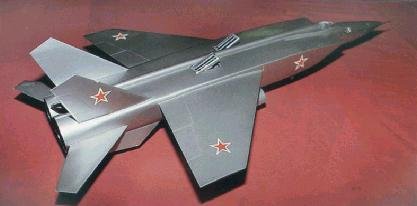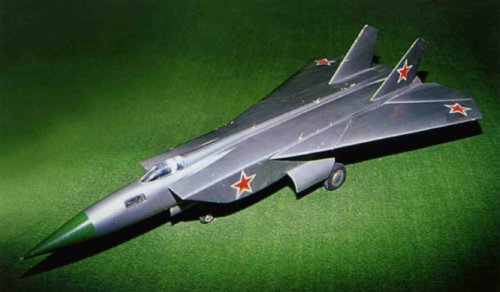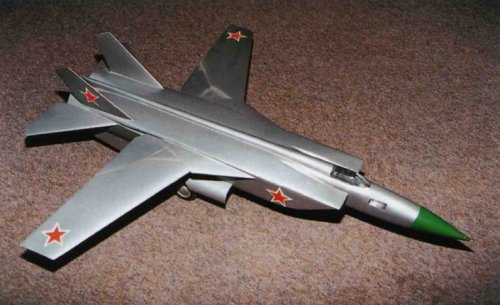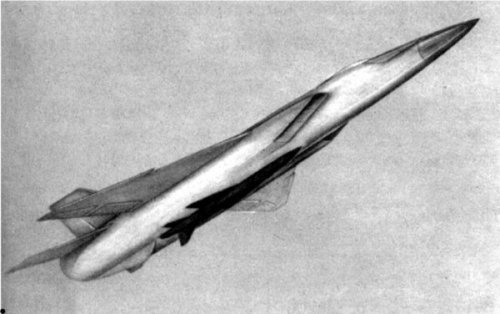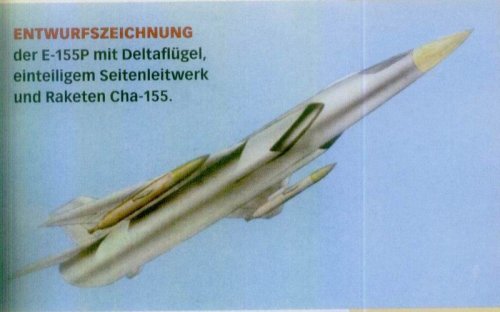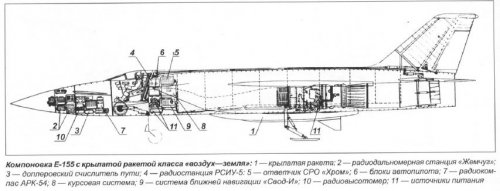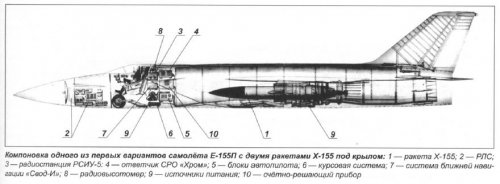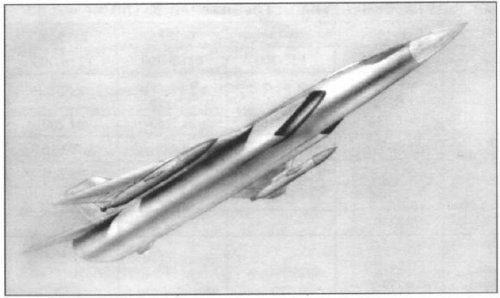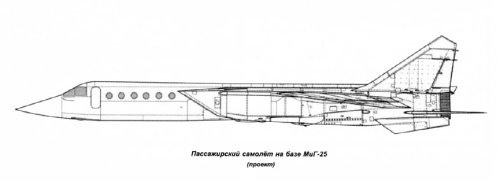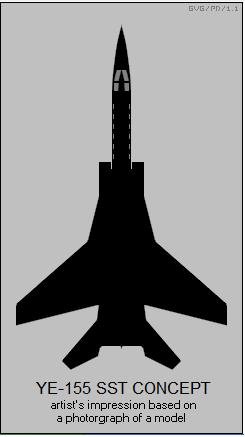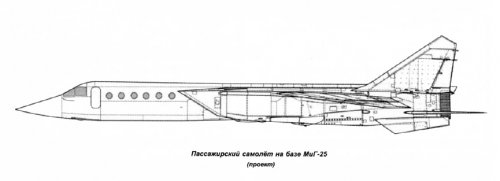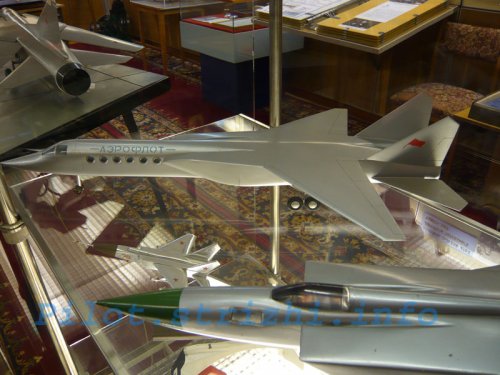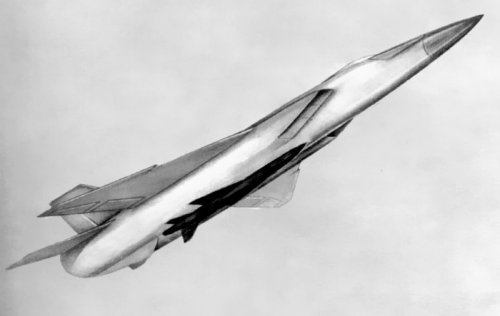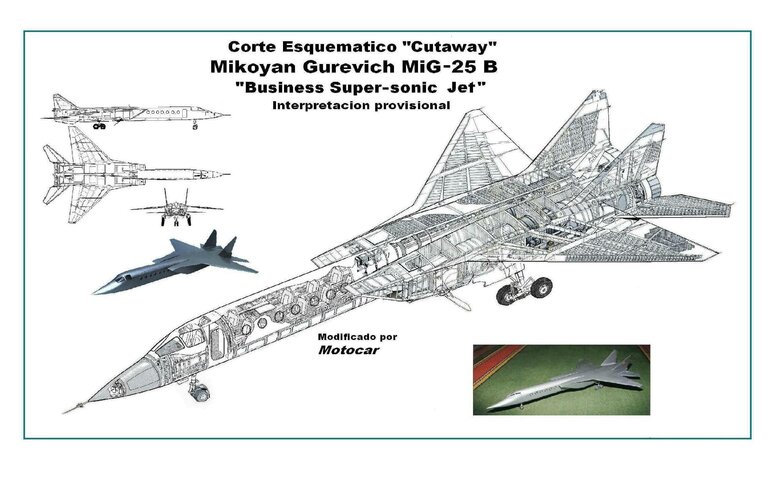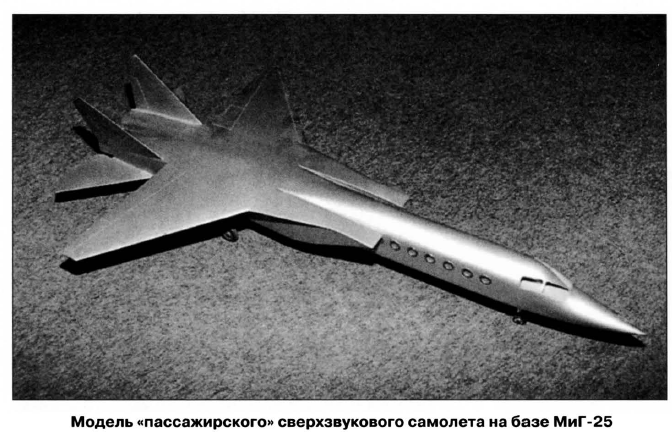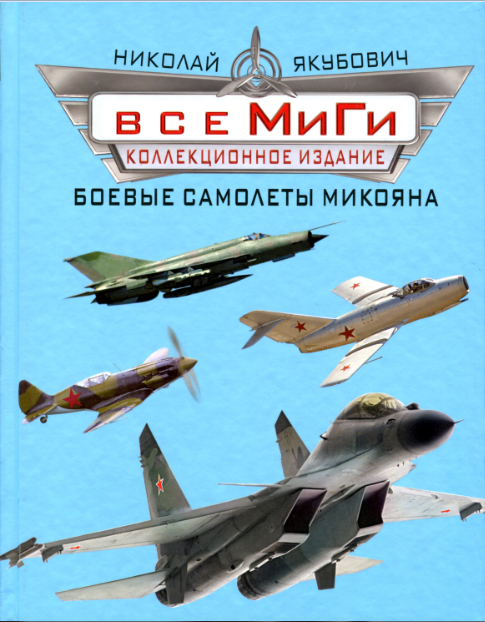You are using an out of date browser. It may not display this or other websites correctly.
You should upgrade or use an alternative browser.
You should upgrade or use an alternative browser.
Mikoyan MiG-25 Projects
- Thread starter hesham
- Start date
- Joined
- 27 December 2005
- Messages
- 16,446
- Reaction score
- 19,126
Merged topics. Here's a picture published in a recent Russian book about MiG by Eksmo which is an early Ye-155 layout with a strike cruise missile under the fuselage. Note the canard foreplanes on the nose and the more delta-looking wing shape. An inboard view of the same design was in the recent Red Star 34 MiG-25 by Yefim Gordon.
Attachments
- Joined
- 27 December 2005
- Messages
- 16,446
- Reaction score
- 19,126
You can see the family tree to Ye-150/152 in this design. Ventral strake and tailplane are close. Wing has a dogtooth but seems largely delta still. Forward canard was intended on Ye-152M. Difficult to tell if its twin vertical tails.

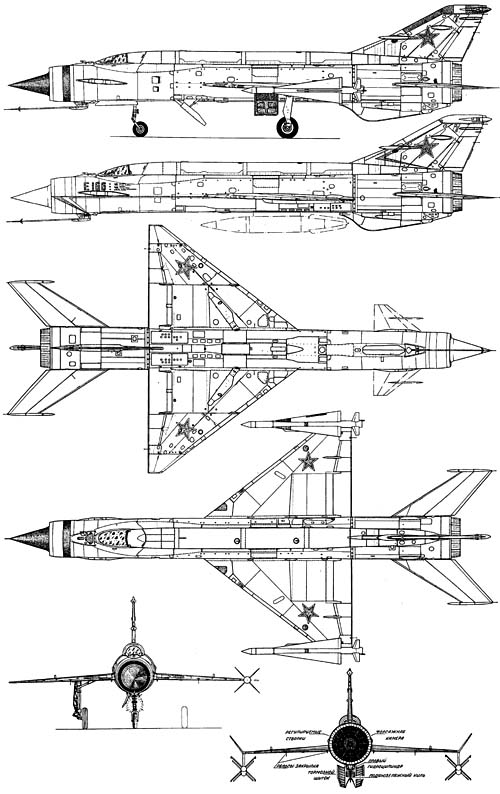
- Joined
- 27 December 2005
- Messages
- 16,446
- Reaction score
- 19,126
From Andrei Fomin article in Air Fleet on the Ye-150/152
Look at the timeline, it seems that the Ye-152M's intended canards were probably to test this element planned for the Ye-155.
In line with the directive of the Council of Ministers dated 5 February,
1962, a provision was made both to further develop the E-155
R15B-300-powered aircraft in the reconnaissance aircraft and interceptor
variants and to convert two E-152s for testing elements of the S-155
intercept system being under development. In accordance with that, it was
envisaged to fit the E-152/1 with new R15B-300 engines and carry out its
flight trials. Besides, a decision was taken to equip the E-152/2 with the
Smerch-A radiocontrol and homing system, as well as with K-80 missiles in
order to test and prepare them for the E-155P interceptor.
In 1962, a working draft was developed with all necessary drawings issued.
The work on conversion of the E-152/1 into the E-152M/1 began after the
world records had been set on it. The R15B-300 engines, featuring enhanced
thrust and an all-mode nozzles, were installed on the aircraft. Extra fuel
load was added. It was housed by three detachable grotto tanks and by the
first fuselage tank. It was envisaged to install foreplanes. Due to this,
the E-152/1 fuselage's fore and rear sections were redesigned. The work had
been finished by the end of 1962, but sub-standard engines had to be
mounted. The completion of the second prototype was also delayed due to the
lack of the engines. It was assembled only in the first half of 1963,
equipped with sub-standard engines, too, and was sent to the factory flight
testing on 14 June, 1963. The E-152M/2 aircraft was equipped with R15B-300
engines and two K-80 all-aspect homing missiles, mounted on the wing tips.
The aircraft was equipped with the Smerch-A radar with the radio
interception system, SAU-1I Polyot automatic control system with flight
navigation devices, Lazur-M command link system, RSBN-2 Iskra short-range
navigation and landing system and the KSI compass system.
The R15B-300 engine ?8, delivered in November 1963 and installed on the
E-152M/1, ensured only the ground test programme, with the engine started.
The flight trials were not carried out due to the ban on operating the
engine in the air. In 1963-1964, the flight tests failed to begin because
there were no R15B-300 flight-ready engines on hand. That is why further
work on them was cancelled, and it was the E-152A aircraft that was used for
experiments.
Look at the timeline, it seems that the Ye-152M's intended canards were probably to test this element planned for the Ye-155.
- Joined
- 3 June 2006
- Messages
- 2,841
- Reaction score
- 2,534
In the May issue of German magazine "Flug-Revue" there was an article about the Mig-25.
Link: http://www.flugrevue.de/de///flug-revue-may-2010.22436.htm
A picture published in that article showed a Mig E-155P (or Ye-155P) with 2 missiles (K-155 ??? ) under the wings.
I took a quick shot with my mobile phone camera (Sony K750i) at the local newsagent.
I'll try to get a better scan during the next few days. But I presume, that other German members in this forum like Deino, boxkite or Jemiba might have a copy at home...
Link: http://www.flugrevue.de/de///flug-revue-may-2010.22436.htm
A picture published in that article showed a Mig E-155P (or Ye-155P) with 2 missiles (K-155 ??? ) under the wings.
I took a quick shot with my mobile phone camera (Sony K750i) at the local newsagent.
I'll try to get a better scan during the next few days. But I presume, that other German members in this forum like Deino, boxkite or Jemiba might have a copy at home...
Attachments
- Joined
- 27 December 2005
- Messages
- 16,446
- Reaction score
- 19,126
I'm interested in getting more details of that article, maybe get a copy of the magazine. It doesn't appear to have any cockpit... Definitely seems single vertical fin too.
K-155 missile was mentioned in the article quoted above but perhaps they are rocket boosters underwing, not missiles?
K-155 missile was mentioned in the article quoted above but perhaps they are rocket boosters underwing, not missiles?
In conclusion, it is necessary to note that the aircraft with the factory
designation E-155 was, at first, slated for operating as part of the
Uragan-5 intercept system. In accordance with the above resolution of the
Council of Ministers of 4 June, 1958, three E-155 interceptors powered by a
combined powerplant (turbojet engine + liquid-propellant rocket engine) were
to be submitted for factory flight trials in the second quarter of the 1960.
They were designed to intercept targets at an altitude of up to 30-35 km at
a 140-170 km range. Their maximum speed was to be 3,500-4,000 km/h. At the
first stage of the testing, the armament was to consist of K-9 missiles, and
further K-155 missiles. Besides, development of four unmanned reusable STOL
interceptors, designed to operate from unpaved airstrips, was planned and
produce them for tests in the fourth quarter of 1961. However, it did not
proceed beyond the conceptual design stage.
- Joined
- 3 June 2006
- Messages
- 2,841
- Reaction score
- 2,534
After taking the picture with my phone camera at my local newsagent, I skimmed over the article. I remember reading not anything new or unknown about the Mig-25 development. "Ye-155" was only mentioned in the picture caption.
The caption also mentions that that shown Ye-155P has a delta wing and a single vertical fin too.
I'll try to lend out the May issue at my local library in the next 10-14 days. A better picture scan and a short summary will be posted in this topic. Of course, I won't attach the full scanned article to this topic.
The caption also mentions that that shown Ye-155P has a delta wing and a single vertical fin too.
I'll try to lend out the May issue at my local library in the next 10-14 days. A better picture scan and a short summary will be posted in this topic. Of course, I won't attach the full scanned article to this topic.
Complex intercept S-155 (1960)
consisted of a fighter interceptor Ye-155P engine R15M-300 and two all perspectiveness guided missiles air-to-air K-9, in addition to suspended under the wing of two guided rockets Kh-155 (rus. X-155)
from N.Yakubovitch "MiG-25"
consisted of a fighter interceptor Ye-155P engine R15M-300 and two all perspectiveness guided missiles air-to-air K-9, in addition to suspended under the wing of two guided rockets Kh-155 (rus. X-155)
from N.Yakubovitch "MiG-25"
Attachments
- Joined
- 27 December 2005
- Messages
- 16,446
- Reaction score
- 19,126
Right, so its Kh-155. But Ye-155P with Kh-155 sounds wrong, Kh is used for air-to-surface missiles.
MiG-25 book is "Aviakollektsiya" 05/2010
Website here (but out of date) http://modelist-konstruktor.ru/index.php?i=ak
MiG-25 book is "Aviakollektsiya" 05/2010
Website here (but out of date) http://modelist-konstruktor.ru/index.php?i=ak
Hammer Birchgrove
ACCESS: Top Secret
- Joined
- 13 May 2009
- Messages
- 583
- Reaction score
- 36
Can I assume that it used blown flaps? Would it still work after being subjected to the heat from flying in Mach 2.8-3 (if that was the intended maximum speed)?hesham said:Hi,
The E-155UVP as STOL aircraft project.
Hammer Birchgrove
ACCESS: Top Secret
- Joined
- 13 May 2009
- Messages
- 583
- Reaction score
- 36
Has there ever been plans or paper projects on making a MiG-25 with the weapon system of a MiG-31 (look-down, shoot-down Pulse-Doppler radar etc)? I imagine it would make a truly deterring interceptor (about as advanced as a CF-105 Arrow with ram-jets or the XF-108 Rapier), and have a better chance of taking down SR-71 Blackbirds. (JA 37 Viggens were able to detect Blackbirds flying over or near Swedish territory.)
- Joined
- 24 January 2006
- Messages
- 1,304
- Reaction score
- 310
The Ye-155A project would've added the Smerch-100 FCS, which did become the FOXHOUND's Zaslon. A lot later there was also the MiG-25PDM proposal, which would've added the MiG-29/Su-27 FCS, but they realized that the R-27 wasn't compatible with high-Mach external carriage. Dunno why that was their reason for dropping it, as they were able to make the Kh-58 work. But, I don't think they ever seriously looked at adding the MiG-31 weapon system back into a FOXBAT. I think there was talk of an upgrade adding the R-33 and perhaps elements of the Zaslon, but I can't remember the details. Syria was mentioned as a potential customer for that refit.
SidewinderX
ACCESS: Restricted
- Joined
- 15 December 2010
- Messages
- 7
- Reaction score
- 0
Hi All --
I'm currently putting together a little write-up about the MiG-25 derived SSBJ design that the bureau worked on from 1963-1965. I've got information from the three sources below, and a couple of photos of the model (one from each book), but I was wondering if anyone else had come across this design and had some info to share. Thanks!
Karnozov, Vladimir (2003). Class Struggle. Flight International. 10 June 2003. http://www.flightglobal.com/articles/2003/06/10/166548/class-struggle.html . Retrieved: 16 December 2010.
Belyakov, R. A., and J. Marmain (1994). MiG: Fifty Years of Secret Aircraft Design. Naval Institute Press, Annapolis, Maryland. pp. 402-403.
Gordon, Yefim (1997). MiG-25 'Foxbat' and MiG-31 'Foxhound. Midland Publishing Limited, Leicester, England. pp. 11-12.
I'm currently putting together a little write-up about the MiG-25 derived SSBJ design that the bureau worked on from 1963-1965. I've got information from the three sources below, and a couple of photos of the model (one from each book), but I was wondering if anyone else had come across this design and had some info to share. Thanks!
Karnozov, Vladimir (2003). Class Struggle. Flight International. 10 June 2003. http://www.flightglobal.com/articles/2003/06/10/166548/class-struggle.html . Retrieved: 16 December 2010.
Belyakov, R. A., and J. Marmain (1994). MiG: Fifty Years of Secret Aircraft Design. Naval Institute Press, Annapolis, Maryland. pp. 402-403.
Gordon, Yefim (1997). MiG-25 'Foxbat' and MiG-31 'Foxhound. Midland Publishing Limited, Leicester, England. pp. 11-12.
- Joined
- 6 November 2010
- Messages
- 4,227
- Reaction score
- 3,158
Quote from "MiG Aircraft since 1937" by Bill Gunston & Yefim Gordon, Putnam 1998:
The wing of the bizjet model appears to be different from the stubbier wing of the MiG-25 as built. The model as shown by Belyakov/Marmain has an Aeroflot-text above the passenger windows, but I recall from years ago Soviet military transports often wore Aeroflot-livery.Ye-155 bizjet project
Studied in 1963-65, this would have had a wing of increased span and a new forward fuselage equipped with up to seven passenger seats or up to 1,000kg (2,205lb) of urgent cargo. The entrance door was on the left behind the cockpit. The fuselage was slightly wider, increasing fuel capacity to give a range of up to 3,500km (2,175 miles) at Mach 2.35. The VVS showed some interest, but the work was mainly funded by the OKB, which decided that the probable market did not justify the large design effort.
SidewinderX
ACCESS: Restricted
- Joined
- 15 December 2010
- Messages
- 7
- Reaction score
- 0
Thanks for contributing that -- I hadn't seen that vectorsite top-view.
- Joined
- 1 April 2006
- Messages
- 10,726
- Reaction score
- 6,736
Photo from Sergey Kuznetcov aka Pilot from his MiG museum walkaround
Attachments
XP67_Moonbat
ACCESS: Top Secret
- Joined
- 16 January 2008
- Messages
- 2,246
- Reaction score
- 376
Looking at this idea, it couldn't have been a comfortable ride.
OM
ACCESS: Top Secret
XP67_Moonbat said:Looking at this idea, it couldn't have been a comfortable ride.
...But it would have at least been a *fun* one
XP67_Moonbat
ACCESS: Top Secret
- Joined
- 16 January 2008
- Messages
- 2,246
- Reaction score
- 376
Oh yeah, of that, there's no doubt.
- Joined
- 27 December 2005
- Messages
- 16,446
- Reaction score
- 19,126
blackkite
Don't laugh, don't cry, don't even curse, but.....
- Joined
- 31 May 2007
- Messages
- 8,297
- Reaction score
- 5,892
Hi!
" E-155N (first) "carrier" - the aircraft carrier cruise missile project ICD "Rainbow". Odnokilevym aircraft with a delta wing. The project existed before 1961 at the preliminary design stage. I do not create. The aircraft was supposed to set the radio range-finder station "Pearls" Doppler schislitel way VHF radio RSIU-5, directional inertial system, radio compass ARK-54, IFF responder system "Chrome", a system of short-range navigation "Code-I", altimeter etc . On the ventral node suspension involves the installation of one of the KR with inertial guidance Sisem probably ICD development "Rainbow". "
" E-155N (first) "carrier" - the aircraft carrier cruise missile project ICD "Rainbow". Odnokilevym aircraft with a delta wing. The project existed before 1961 at the preliminary design stage. I do not create. The aircraft was supposed to set the radio range-finder station "Pearls" Doppler schislitel way VHF radio RSIU-5, directional inertial system, radio compass ARK-54, IFF responder system "Chrome", a system of short-range navigation "Code-I", altimeter etc . On the ventral node suspension involves the installation of one of the KR with inertial guidance Sisem probably ICD development "Rainbow". "
Last edited by a moderator:
NoBarrelRolls
"C'mon Mav! Do some of that pilot s#!t!"
Hi Motocar, would you share the cutaway in this thread please?I have the cutaway drawing...!
SleeperService2
Not sure about changing it now.
- Joined
- 16 August 2016
- Messages
- 70
- Reaction score
- 96
Here's the cutaway I think Motocar is referring to. However you need a big pinch of salt. In the book seating is one abreast down the LHS with an aisle to the right. The drawing shows two and an aisle something would have to be quite tiny....
New link for the Flight article https://www.flightglobal.com/class-struggle/48677.article
New link for the Flight article https://www.flightglobal.com/class-struggle/48677.article
Attachments
- Joined
- 27 December 2005
- Messages
- 16,446
- Reaction score
- 19,126
Yes the cutaway is entirely fictional.Here's the cutaway I think Motocar is referring to. However you need a big pinch of salt. In the book seating is one abreast down the LHS with an aisle to the right. The drawing shows two and an aisle something would have to be quite tiny....
New link for the Flight article https://www.flightglobal.com/class-struggle/48677.article
SleeperService2
Not sure about changing it now.
- Joined
- 16 August 2016
- Messages
- 70
- Reaction score
- 96
I feel the same way. There are two models and two sets of drawings and they seem to show two stages of the same design. The cutaway drawing shows both versions as models. As it was never built it's likely there were several design stages as different problems surfaced.I feel the cockpit was different ?.
- Joined
- 1 April 2006
- Messages
- 10,726
- Reaction score
- 6,736
It's the same model all over againI feel the cockpit was different ?.
Blitzer9856
ACCESS: Restricted
- Joined
- 13 August 2019
- Messages
- 48
- Reaction score
- 66
While the Ye-155P was still under development (what would become the prototype of the MiG-25), plans were considered for a version of the aircraft with variable geometry.

These plans were drawn on the basis of the Ye-155R - the planned recon version of the Foxbat. It would have had a total of two crew members and its wings resembled the FB-111A's greatly.
This was designated as the Ye-158, a project intended to produce an aircraft for high-speed, high-altitude PHOTINT and ELINT, with a secondary tactical bomber role. It would have been also able to carry tactical nukes. However the variable geometry wings increased its maximum takeoff weight and the wing design was of little use to the aircraft's primary mission, nor was STOL called for due to it envisioned as being too heavy for that; originally there was also the idea that it would be able to operate from short landing strips, and the navigator seat idea was deemed unnecessary and thus dropped in the MiG-25R.
Never made it to the prototype phase past the drawing board. Only models existed.
The design performance is as follows:
Takeoff weight: 40,000 - 40,500 kg
Maximum speed:
More pictures..







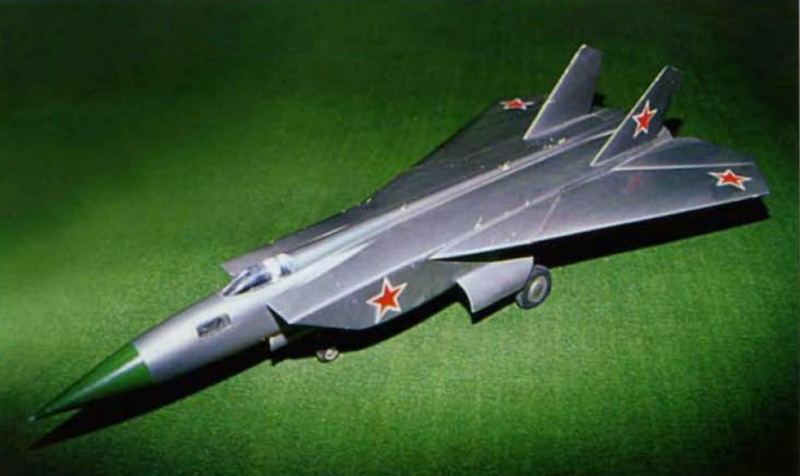
These plans were drawn on the basis of the Ye-155R - the planned recon version of the Foxbat. It would have had a total of two crew members and its wings resembled the FB-111A's greatly.
This was designated as the Ye-158, a project intended to produce an aircraft for high-speed, high-altitude PHOTINT and ELINT, with a secondary tactical bomber role. It would have been also able to carry tactical nukes. However the variable geometry wings increased its maximum takeoff weight and the wing design was of little use to the aircraft's primary mission, nor was STOL called for due to it envisioned as being too heavy for that; originally there was also the idea that it would be able to operate from short landing strips, and the navigator seat idea was deemed unnecessary and thus dropped in the MiG-25R.
Never made it to the prototype phase past the drawing board. Only models existed.
The design performance is as follows:
Takeoff weight: 40,000 - 40,500 kg
Maximum speed:
- at sea level: 1,400 - 1,500 km/h
- at high altitude: 3,000 - 3,500 km/h
- at sea level: 1,600 km
- at high altitude (subsonic): 5,000 km
- at high altitude (supersonic): 2,500 km
More pictures..
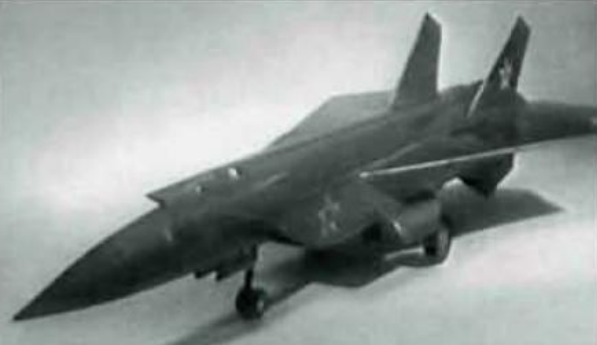
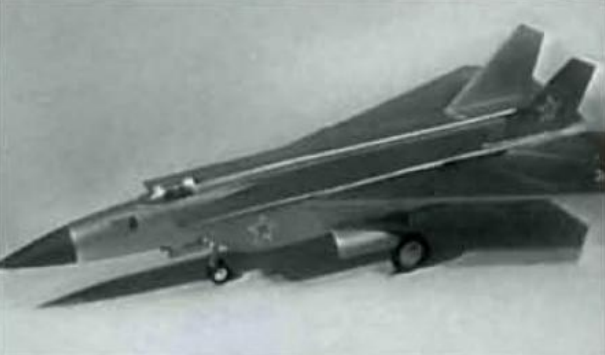
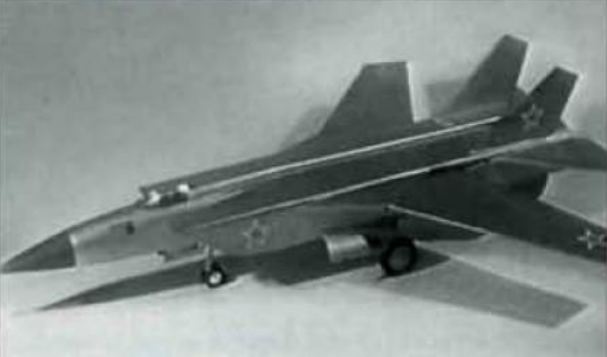
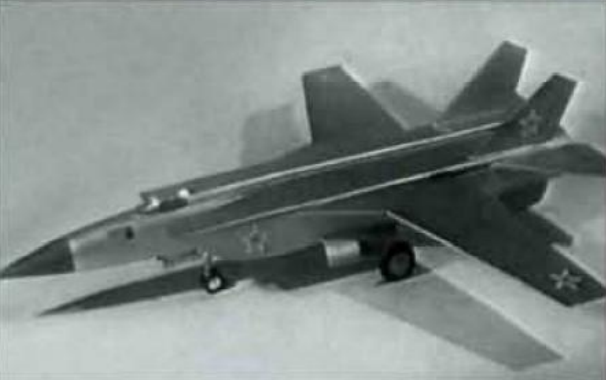
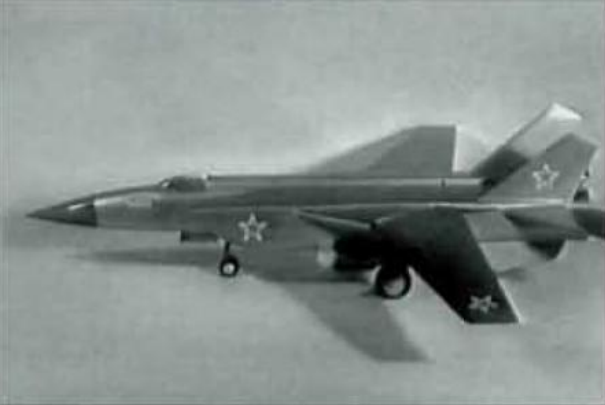
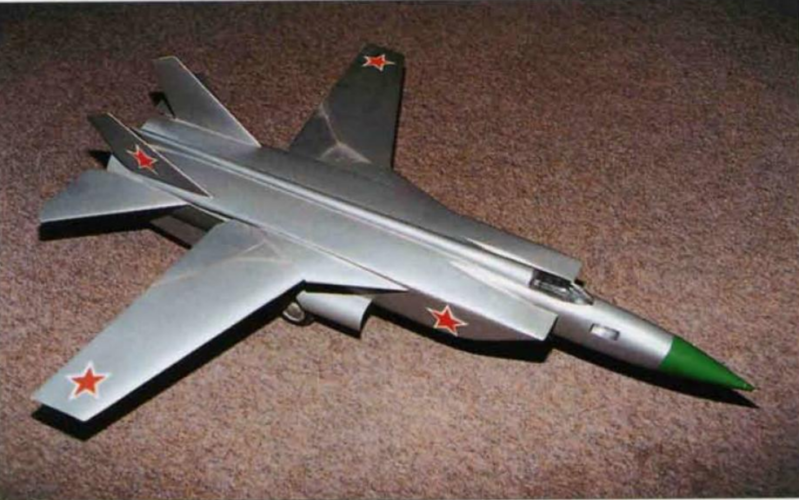
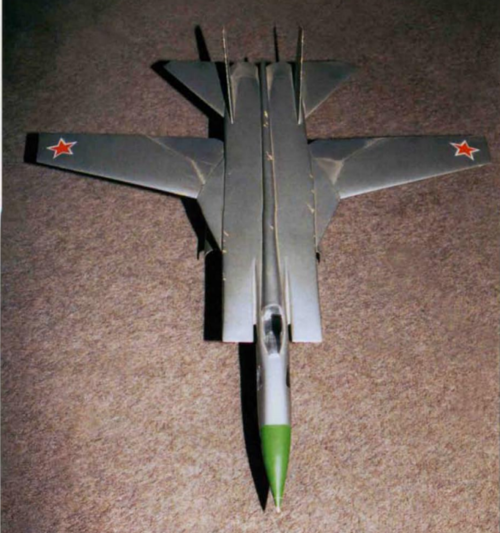
- Joined
- 9 October 2009
- Messages
- 19,900
- Reaction score
- 10,409
If that had appeared on the scene, it would have probably led to among other things the USAF F-14 purchase going through, and in record time!
- Joined
- 9 October 2009
- Messages
- 19,900
- Reaction score
- 10,409
Cluster bombs I think, can't remember their designation off hand. (Think I need an infusion of tea, stat!)
- Joined
- 25 July 2007
- Messages
- 3,870
- Reaction score
- 3,170
what was those bombs ?.
I'm already on my second cup!
These look like the FAB-500 M-62 general purpose HE bombs. The BETAB-500 concrete-piercing bombs are similar in appearance but have prominent tailcone attachment points (although, those could just have been omitted in the drawing).
Similar threads
-
-
-
-
-
Soviet Aircraft - cost of construction and purchase?
- Started by overscan (PaulMM)
- Replies: 5

